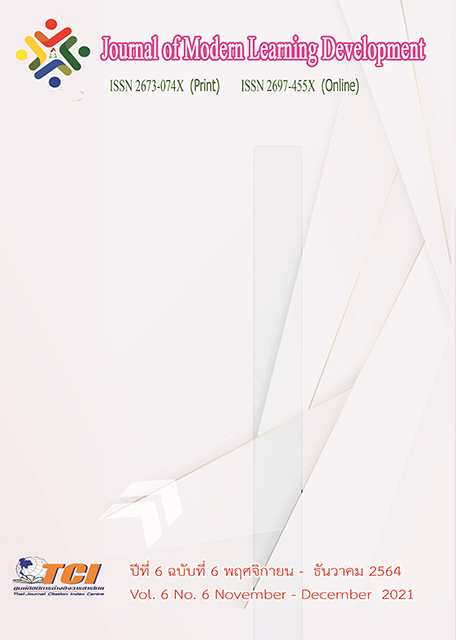The Sangha Administration of Sangha Administrators in the 21st Century
Main Article Content
Abstract
Academic articles on “Sangha Administration of Sangha Administrators in the 21st Century” aims to present guidelines for applying the administration of Sangha affairs, which have 6 aspects, namely: on Administration, on ecclesiastical education, On public supporting education, on propagation of Buddhism, on constructions and reparation, On social welfares. This is a practice for the Sangha by the upreme Sangha Council that was established in 1962, but when the world turns around Everything in the world will change accordingly. Both economically, socially and politically, as well as psychologically that the bishop will manage the affairs of the Sangha in the same way it can be done, but it may prevent the work of Buddhism to drive efficiency and effectiveness. Adjustment of the bishop in applying the principles of Sangha administration But how to proceed to know how to access and keep up with the changes of the world society? Therefore, it is necessary to adjust the strategy by applying the principles or directions of the Buddha, which has clearly laid out the principles of management. and gentle, can be used in every era and management principles that are modern science in order to be able to implement the principles of administration of all six aspects of Sangha affairs quickly and without causing any impact to those involved This approach, although a simple principle. But if it can be done, it will have a very good effect on the work of the Sangha. Bringing the highest benefits and happiness to Thai society.
Article Details
References
กรมการศาสนา. (2540). คู่มือพระสังฆาธิการว่าด้วยเรื่องการคณะสงฆ์และการพระศาสนา. กรุงเทพมหานคร: โรงพิมพ์การศาสนา.
กรมการศาสนา. (2542). คู่มือพระสังฆาธิการว่าด้วยพระราชบัญญัติ กฎ ระเบียบและคำสั่งของคณะสงฆ์. กรุงเทพมหานคร: โรงพิมพ์การศาสนา.
จันทรานี สงวนนาม. (2536). หลักการ แนวคิดทฤษฎีและเทคนิคการบริหาร. กรุงเทพมหานคร: สำนักงานคณะกรรมการประถมศึกษาแห่งชาติ.
ประเวศ วะสี. (2539). พระสงฆ์กับการเรียนรู้เท่าทันสังคม. กรุงเทพมหานคร: สำนักงานสภาสถาบันราชภัฏ.
พระครูปลัดเกษฎา ผาทอง และคณะ. (2562). บทบาทของพระสงฆ์กับการเสริมสร้างวัฒนธรรมทางการเมืองในพื้นที่ประเทศกัมพูชา ลาว พม่า และไทย. วารสารสันติศึกษาปริทรรศน์ มจร. 7 (6), 1662-1676.
พระราชปริยัติโมลี (ไพบูลย์ วิปุโล). (2554). การบริหารกิจการคณะสงฆ์ของเจ้าอาวาสในเขตปกครองคณะสงฆ์จังหวัดสุพรรณบุรี. วิทยานิพนธ์พุทธศาสตรมหาบัณฑิต สาขาวิชาการจัดการเชิงพุทธ. บัณฑิตวิทยาลัย: มหาวิทยาลัยมหาจุฬาลงกรณราชวิทยาลัย.
ไพรถ เลิศพิริยกมล. (2539). สภาพปัญหาสังคมไทยในยุคโลกาภิวัตน์. กรุงเทพมหานคร: สำนักงานสภาราชภัฏ.
มหาวิทยาลัยมหาจุฬาลงกรณราชวิทยาลัย. (2539). พระไตรปิฎกภาษาไทย ฉบับจุฬาลงกรณราชวิทยาลัย.กรุงเทพมหานคร: โรงพิมพ์มหาวิทยาลัยมหาจุฬาลงกรณราชวิทยาลัย.
มานพ พลไพรินทร์. (2531). คู่มือการบริหารกิจการคณะสงฆ์. กรุงเทพมหานคร: ชุติมาการพิมพ์.
วิโรจน์ สารรัตนะ. (2546). การบริหารการศึกษา : หลักการ ทฤษฎี หน้าที่ ประเด็นและบทวิเคราะห์. (พิมพ์ครั้งที่ 4). กรุงเทพมหานคร: ทิพย์วิสุทธิ์.
สำนักงานพระพุทธศาสนาแห่งชาติ. (2554). คู่มือพระสังฆาธิการ. สำนักเลขาธิการมหาเถรสมาคม. กรุงเทพมหานคร: สำนักงานพระพุทธศาสนาแห่งชาติ.
สำนักงานเลขาธิการมหาเถรสมาคม. (2542). คู่มือพระสังฆาธิการและพระวินยาธิการ. กรุงเทพมหานคร: กระทรวงศึกษาธิการ.
พระอธิการผจญ อาจาโร (ทนันจง). (2553). ศึกษาบทบาทของพระสงฆ์ในการบริหารจัดการวัดโดยใช้หลัก ธรรมาภิบาล: ศึกษาเฉพาะกรณีอำเภอบ้านโฮ่งจังหวัดลำพูน. วิทยานิพนธ์พุทธศาสตรมหาบัณฑิต. สาขาวิชาพระพุทธศาสนา. บัณฑิตวิทยาลัย: มหาวทิยาลยัมหาจุฬาลงกรณราชวิทยาลัย.
Spencer and Spencer. (1993). Competency at Work: Model for Superior Performance. New York: Wily & Sons.


